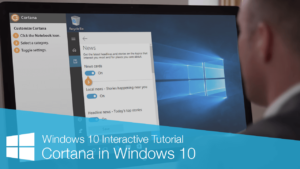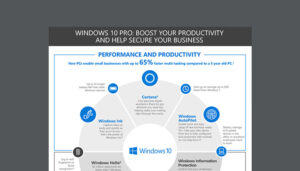Unveiling the Power of Cortana Integration in Windows 10: A Comprehensive Exploration

Introduction:
With the advent of Windows 10, Microsoft introduced a revolutionary feature that transformed the way users interact with their computers – Cortana. Named after the AI character in the Halo video game series, Cortana is Microsoft’s virtual assistant designed to enhance productivity and provide a personalized computing experience. This comprehensive exploration delves into the intricacies of Cortana integration in Windows 10, unraveling the capabilities, features, and potential of this intelligent virtual assistant.
I. The Evolution of Virtual Assistants: Cortana’s Genesis
- The Birth of Cortana: A Futuristic Vision:
- Cortana made its debut with the release of Windows Phone 8.1 in 2014, showcasing Microsoft’s vision of an AI-driven virtual assistant capable of understanding natural language commands and providing context-aware responses.
- Windows 10: Cortana’s Expansion to Desktops:
- Windows 10 marked the expansion of Cortana from mobile devices to desktops and laptops. Integrated into the taskbar, Cortana became a central component of the Windows 10 user experience, offering voice commands, search capabilities, and personalized assistance.
II. Getting Started with Cortana: Activation and Customization
- Enabling Cortana: A Personal AI at Your Fingertips:
- Cortana is seamlessly integrated into Windows 10, accessible through the taskbar. Users can activate Cortana by clicking on the microphone icon or by using the voice command, “Hey Cortana,” if the feature is enabled.
- Customizing Cortana Settings: Tailoring the Experience:
- Users have the flexibility to customize Cortana’s settings according to their preferences. This includes adjusting privacy settings, choosing whether Cortana responds to voice commands, and configuring the level of personalization.
III. Voice Commands and Conversational Interface:
- “Hey Cortana”: Voice Activation for Seamless Interaction:
- The “Hey Cortana” feature allows users to activate the virtual assistant through voice commands. This hands-free capability enhances accessibility and fosters a conversational interaction with the AI.
- Natural Language Processing: Understanding User Intent:
- Cortana leverages natural language processing (NLP) to understand user intent and context. This enables users to interact with Cortana in a conversational manner, asking questions, setting reminders, or initiating tasks using everyday language.
IV. Search and Information Retrieval: Cortana’s Information Gateway
- Bing-Powered Search: Seamless Access to Information:
- Cortana integrates with Microsoft’s Bing search engine, providing users with quick access to web-based information. Users can ask Cortana questions, and the AI utilizes Bing to retrieve relevant search results.
- Personalized Recommendations: Tailored Content Suggestions:
- Cortana utilizes machine learning algorithms to understand user preferences and behavior. This enables the virtual assistant to offer personalized content recommendations, such as news articles, weather updates, and suggested actions.
V. Cortana and Productivity: Task Automation and Reminders
- Setting Reminders and Alarms: A Personal Assistant’s Touch:
- Cortana excels at managing reminders and alarms. Users can instruct Cortana to set reminders for specific tasks, appointments, or deadlines. The virtual assistant ensures timely notifications and keeps users organized.
- Task Automation with Cortana: Streamlining Workflows:
- Cortana extends its capabilities to automate tasks and streamline workflows. Users can create voice-activated commands to initiate specific actions, open applications, or perform routine tasks, enhancing overall productivity.
VI. Integration with Microsoft 365: Seamless Collaboration
- Cortana and Microsoft 365: A Unified Ecosystem:
- Cortana seamlessly integrates with the Microsoft 365 suite, providing a unified ecosystem for productivity. Users can leverage Cortana to access calendar events, emails, and collaborate with colleagues through voice commands.
- Outlook Integration: Managing Emails with Ease:
- Cortana simplifies email management by allowing users to compose, read, and respond to emails through voice commands. The integration with Outlook enhances efficiency and facilitates hands-free communication.
VII. Cortana Skills: Expanding Capabilities through Third-Party Integration
- Introduction to Cortana Skills: Extending Functionality:
- Cortana Skills are third-party integrations that expand the virtual assistant’s capabilities. Developers can create Skills to enable Cortana to interact with external services, apps, and devices, broadening its functionality.
- Smart Home Integration: Control Devices with Cortana:
- Cortana’s integration with smart home devices enables users to control lights, thermostats, and other IoT devices using voice commands. This seamless integration contributes to creating a connected and intelligent living space.
VIII. Cortana and Accessibility: Empowering Users
- Accessibility Features: Inclusivity at the Core:
- Cortana plays a crucial role in enhancing accessibility for users with disabilities. Voice commands, natural language processing, and hands-free interactions contribute to a more inclusive computing experience.
- Visual and Cognitive Assistance: Aiding Users in Need:
- Cortana extends visual and cognitive assistance by providing spoken descriptions of on-screen content. This feature assists users with visual impairments in navigating and interacting with their computers.
IX. Privacy Considerations: Cortana and User Data
- Privacy Controls: Empowering Users with Choices:
- Microsoft prioritizes user privacy, providing robust privacy controls for Cortana. Users can manage data collection settings, review and delete voice recordings, and tailor the level of personalization according to their comfort.
- Data Security Measures: Safeguarding User Information:
- Cortana employs stringent data security measures to protect user information. Microsoft implements encryption protocols and anonymizes data to ensure the confidentiality and integrity of user interactions with Cortana.
X. Cortana in the Future: Ongoing Development and Enhancements
- Ongoing Development: Microsoft’s Commitment to Innovation:
- Microsoft remains committed to the ongoing development and enhancement of Cortana. Regular updates and feature additions reflect the company’s dedication to providing users with an increasingly intelligent and capable virtual assistant.
- Integration in Future Windows Versions: A Dynamic Landscape:
- The future of Cortana includes its integration in upcoming Windows versions, potentially bringing new features, improved natural language processing, and expanded capabilities to further enrich the user experience.
Conclusion:
Cortana integration in Windows 10 represents a significant leap forward in human-computer interaction. From voice commands and conversational interfaces to personalized recommendations and productivity enhancements, Cortana plays a pivotal role in shaping the way users interact with their computers. As Microsoft continues to invest in the development of Cortana, the virtual assistant is poised to become an even more integral part of the Windows ecosystem, offering users an intelligent, personalized, and efficient computing experience. Embrace the power of Cortana, and let your Windows 10 journey be guided by the insights and capabilities of this groundbreaking virtual assistant.







